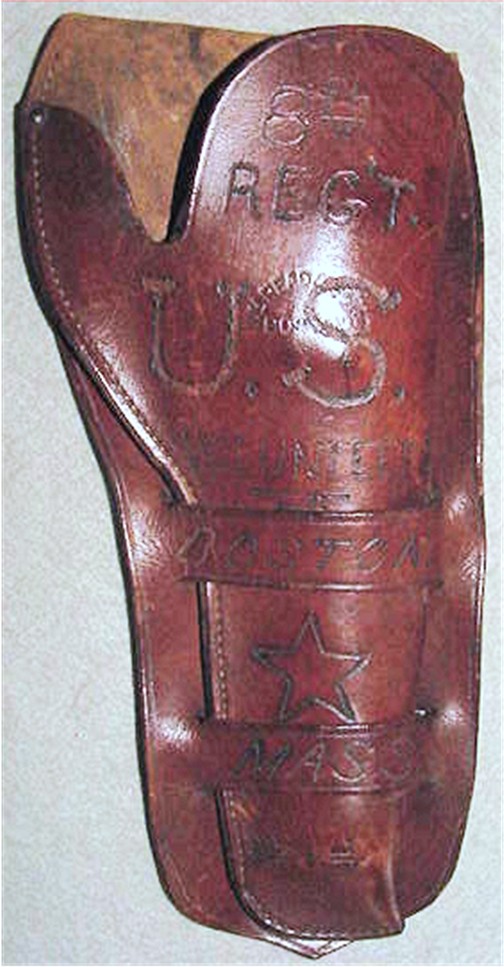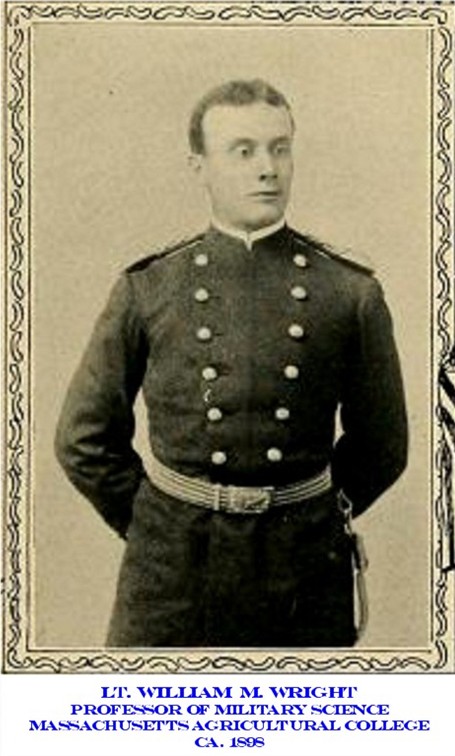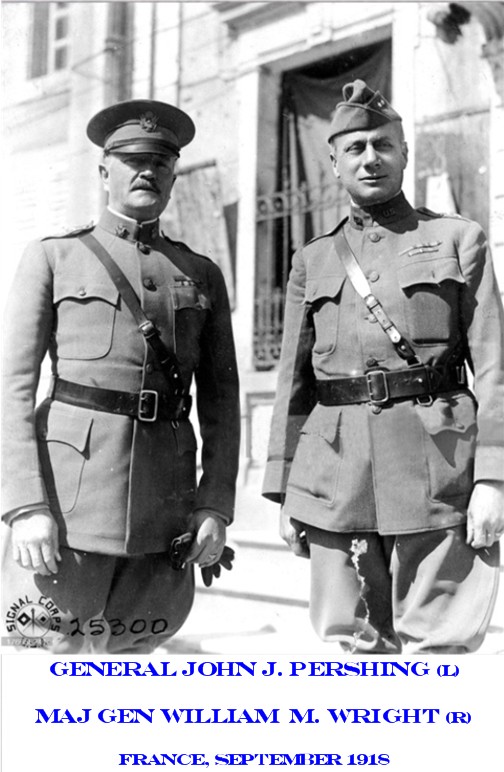|
EXCELLENT HISTORICAL SPANISH
AMERICAN WAR HOLSTER - DOUBLE LOOP BROWN LEATHER
HOLSTER FOR A SINGLE ACTION 5 ½” BARREL COLT REVOLVER –
MAKER MARKED – OFFICER AND UNIT IDENTIFIED – 8TH
MASSACHUSETTS VOLUNTEER INFANTRY:
This is a very well
preserved specimen of a “Mexican” Double Loop Holster
made in the classic size and pattern for carrying the
Colt Single Action Revolver with a 5 ½” barrel. The
collective features of this holster – the maker, the
period of manufacture, the pattern and style, the size,
the unit identification, and the officer’s name – all
combine to create a very interesting artifact from the
Spanish American War.

As evidenced by the legible maker’s mark on the face of
the pistol pouch, this holster was manufactured by the
firm of William Read & Sons of Boston, Massachusetts, a
well known purveyor of military arms, ammunition, and
sporting goods.
In 1826 William Read and
Edward Lane opened their first “gun store”
on Washington Street in
Dock Square, one of Boston’s waterfront mercantile
hubs. After the death of Lane in 1849 Read took over
the business, and in 1854 the firm name was changed to
William Read and Sons. By the onset of the Civil War,
Read & Sons was a large enterprise and sufficiently well
established to enter into contracts to provide arms and
ammunition to federal and state militia units. Read
continued in business until 1921 when the store was
absorbed into the Winchester Repeating Arms Company, so
at the time of the Spanish American War Read’s was still
providing military goods and civilian gun leather to
their customers in the Boston area.
The pistol pouch of the holster is sized specifically
for a large frame, single action revolver with a 5 ½”
barrel. Given the unit and personal identification
carved into the leather, one can safely presume this
holster was intended to, and in fact did, carry one of
the some 16,000 Model 1873 Colt Single Action Revolvers
which the army altered (or “re-modeled” as described by
the Colt Company) by replacing or shortening the
original 7 ½” barrels with 5 ½” barrels. The alteration
of these revolvers, now known to collectors as “The
Artillery Models”, began in 1895 and for all intent and
purposes, was completed in 1898, well in time for them
to be issued during the Spanish American War and used in
Cuba and the Philippine Islands. One of these Artillery
Model Colt Single Action Revolvers was certainly the
pistol carried in this holster.
The front of the holster is decorated with several lines
of hand carved characters which serve to commemorate the
unit with which the owner was affiliated. The face of
the holster is carved:
8th
REGT.
U.S.
VOLUNTEERS
------
-----
---
BOSTON
[STAR EMBLEM]
MASS
[ARROW EMBLEM]
Upon the onset of
the Spanish American War, the 8TH Regiment of
Massachusetts Volunteers was mustered in on May 11TH
through the 14TH in 1898 at South Framingham,
Massachusetts. The regiment’s soldiers were recruited
from the communities of Newburyport (Co. A), Amesbury
(Co. B), Marblehead (Co. C), Lynn (Co. D), Beverly (Co.
E), Salem (Co. H and I), Danvers (Co. K) and Lawrence
(Co. L). Companies F and M were not identified to a
particular town or community, but like the rest of the
regiment the majority of the soldiers were recruited in
Essex County, approximately 35 miles northeast of Boston
along the Massachusetts coast line. It is not
surprising that some of the cadets from the Military
Science Department at the Massachusetts Agricultural
College in Amherst (now the University of Massachusetts)
answered the national call to arms and enlisted in this
regiment. The 8TH served stateside during
the conflict; however it served in Cuba as part of the
occupation force following the war.
While there is not
a “Billy” or William Wright to be found in the Spanish
American War era rosters of the 8TH
Massachusetts Volunteer Infantry Regiment, there is a
William Wright with connections to the 8Th
and the Massachusetts military community at the time of
the SAW. Then First Lieutenant William M. Wright served
as the Professor of Military Science at the
Massachusetts Agricultural College from 1896 to 1898.

Lt. General William Mason Wright was born in Newark, New
Jersey on September 24, 1863. He was the son of US Army
Colonel Edward H. Wright (1824–1913, a career officer
whose service included assignments as aide-de-camp to
Generals Winfield Scott and George B. McClellan),
grandson of Michigan Governor Stevens T. Mason, and
great-grandson of U.S. Senator William Wright of New
Jersey.
Wright recorded an extensive and interesting military
career beginning with his admission to the United States
Military Academy at West Point in 1882 as a member of
the Class of 1896. Fortunate - not only for his career,
but instrumental in confirming the identification of
this holster some 139 years later – that upon arriving
at West Point, Wright was billeted with another
incoming plebe cadet who would be his roommate for the
duration of their freshman year – one John J. Pershing
who would go on to write his own impressive chapter of
U.S. Army history. From this chance billeting
assignment, Wright and Pershing formed a friendship
which would endure throughout their careers.

At the end of the first term in December of 1883,
Wright, fearing that he had failed his exams and would
be dismissed, resigned his appointment at the Military
Academy before the grades were posted.
Upon leaving West Point, Wright
joined the New Jersey National Guard, was commissioned
as a Captain, and served as aide-de-camp to the
commander of the 1ST Brigade. In January of
1885 President Chester A. Arthur nominated Wright for
appointment as a Second Lieutenant in the 2ND
United States Infantry Regiment. The nomination was
opposed by Secretary of War Robert T. Lincoln on the
grounds that someone who had not successfully graduated
from West Point should not receive the same commission
as those who had. In spite of Lincoln’s opposition,
Wright’s commission was narrowly confirmed by the U.S.
Senate, 29 votes to 22. It is notable that when writing
his own memoirs many years later, Pershing generously
chose to record that Wright left West Point only because
he had difficulty passing geometry, and that their
classmates approved of Wright obtaining his commission
through this alternate route, even though through the
odd series of circumstances, Wright’s commission
predated that of his West Point classmates.
In spite of the rocky beginnings,
Wright embarked on what would be a remarkable career,
serving in the West during the Indian Wars, as a
Professor of Military Science as noted above, and on
overseas service during the Spanish American War in
Cuba.
Germane to this holster, as noted above from 1896 to
1898 Lt. Wright was the professor of military science at
the Massachusetts Agricultural College in Amherst (Mass
State College 1931, Univ of Mass 1947). Serving in this
capacity, it is very likely that Wright became familiar
with many of the state militia units, including the 8TH.
At the onset of the Spanish American War, Wright was
promoted to the rank of captain and appointed as the
assistant adjutant general of U. S. Volunteers – the
organizational entity to which the 8TH
Massachusetts would be assigned. Wright served in Cuba
as the aide-de-camp to Major General John C. Bates,
commander of the 3RD Division. Upon
activation on May 19, 1898, the 8TH
Massachusetts Infantry was assigned to the Second
Brigade, Third Division, First Army Corps, again placing
Wright and the 8TH within the same command
structure. It is most likely that Wright was presented
with this holster during this period by soldiers and/or
officers of the 8TH – perhaps some of his
former student-cadets from Massachusetts Agricultural
College. While in Cuba, Wright took part in the Battle
of El Caney and the other actions leading to
the surrender of Santiago.
Having established the distinct likelihood that Wright
obtained or was presented with this holster during the
SAW, it remains to explain the use of “Billy” in the
name carved into the reverse of the holster loop. Why
would such a distinguished officer choose to identify
his accoutrements with such a child-like nickname? This
is where the fortune of Wright’s assignment as
Pershing’s roommate smiles on the identification of this
holster.
Pershing was an almost
compulsive diarist, and not only did he record his daily
activities in detail, but he then retained those
diaries, letters, telegrams, reports, meeting agendas,
and personal papers in such an all-inclusive manner as
to preserve even such records as his wedding plans and
wedding gift registries (where Wright’s gift is
recorded) for the remainder of his life, leaving behind
an impressive archive which survives today in the
Library of Congress.
Pershing’s 1886 diary includes a detailed description of
a several day long excursion he and a number of his
fellow officers made to New York City on June 14
following his class’s graduation and commissioning
earlier that same month. The diary entry records that
while dining that evening at Martinelli’s Restaurant,
they were joined by former classmates including “Wm.
M. Wright of Newark, N.J.”. Pershing continues,
describing his activities in New York during that visit,
and makes two specific references of his time spent with
“Billy Wright”, suggesting that Wright’s nickname
of “Billy” was in common use among his friends as early
as 1886.
The surviving historical record suggests one final
observation worth noting regarding the possible origin
of Wright’s nickname, “Billy”. I could find no
biographical reference to Wright using, or having been
called, “Billy” prior to his entry into West Point.
While it is a common enough alteration of William,
Wright appears to have been raised in a relatively
formal home environment, the type of home during the
strict Victorian Age in which the use of such a nickname
would have been out of character. On the other hand,
cadets at West Point were (and are) known to assign
nicknames to their fellow cadets as a matter of course.
So popular and so ingrained in the culture of the
academy was the practice, that the nicknames were
commonly published with the graduating cadet’s
photograph in his class’s edition of The Howitzer,
the West Point yearbook. Further, it seems that it was
not unusual that some of those nicknames survived
throughout the graduate’s entire life.
General Pershing left an interesting entry in his 1934
diary that reveals his feelings regarding such
nicknames. As he was assembling notes for inclusion in
his autobiography, Pershing reflected specifically on
the use of the nickname “Billy” for another famous
William. He wrote, referring to Gen. William T.
Sherman, “He was familiarly known as Billy by his
admirers and the lessons he taught made a lasting
impression on me...”. Considering the life long
friendship apparently shared by Generals Pershing and
Wright, and Pershing’s reflection on the affectionate
use of “Billy” by Sherman’s friends, it is entirely
possible that Pershing very well may have been the one
who dubbed William Wright as “Billy” in that first
semester at West Point.
Wright was a highly regarded trainer of soldiers and
combat leader. In May of 1908 he was promoted
to major and assigned as adjutant of the 8TH
United States Infantry Regiment, then stationed in the
Philippines. During the Punitive Expedition into Mexico
in 1916, he participated in both the Vera Cruz Landing
and Pershing’s campaign into northern Mexico. He went
on to command the 35th and 89th Infantry Divisions, and
the I, III, V, and VII Corps – all with the American
Expeditionary Force during World War One. Pershing
commended Wright's leadership during World War I, as did
former Army Chief of Staff General Leonard Wood and
senior British commander Field Marshal Douglas Haig, and
Wright was awarded the Distinguished Service Medal in
January, 1919.
After the Armistice was signed in
Europe, Wright served as Executive Assistant to
the Chief of Staff of the United States Army, and acted
as an interim Chief of Staff on several occasions. He
closed his career by serving as head of the Department
of the Philippines from 1922 until his retirement in
1923 at the rank of major general. In 1942, the U.S.
Congress passed legislation allowing retired Army
generals to be advanced one rank on the retired list or
posthumously, if they had been recommended in writing
during World War I for a promotion which they did not
receive, and if they had received the Medal of Honor,
the Distinguished Service Cross or the Distinguished
Service Medal. Wright and James G. Harbord were
promoted to lieutenant general on July 9, 1942. Lt.
General Wright passed away in Washington D.C. on August
16, 1943.
The use of the .45 caliber Colt Single Action Revolvers
in the Philippines after the turn of the century is very
well documented, and Wright most certainly could have
taken this holster with him when he transferred to the
Philippines in 1908. Depending on Wright’s personal
preference of pistols, even though the Model 1911
Automatic Colt Pistol had been issued by the time he
served on the Mexican border during the Punitive
Expedition, the dependable .45 caliber Colt SA’s were
still in favor among veteran officers, and it is
entirely possible he continued to carry a single action
revolver in this holster during that assignment.
This very attractive holster’s leather surfaces retain a
bright, clear, shiny surface - smooth with no crazing or
flaking and all of the stamps and carvings described
above are fully legible. The leather is supple and
holds its shape with no weaknesses.
While this holster was
definitely used on a regular basis during its period of
service, bearing the impressions on the interior of the
holster indicating that it carried a revolver, the
holster has not been abused or worn out. The seam is
fully intact down through the rounded toe with no loss
of the stitching. The holster measures 11” OAL and 5”
OAW. The belt loop formed by the skirt will easily
accept a 4” wide cartridge belt – plenty of space to
accommodate any of the Mills Woven Cartridge Belts of
the era.
An archive of copies of
photographs, entries from General Pershing’s diaries and
personal records, and records pertinent to General
Wright’s life will accompany the sale of this holster.
This is a very scarce surviving specimen of the private
purchase holsters carried by army officers in the 19TH
Century, with the added value of being identified to a
long serving officer who served during many key
campaigns in our nation’s history. SOLD
|

